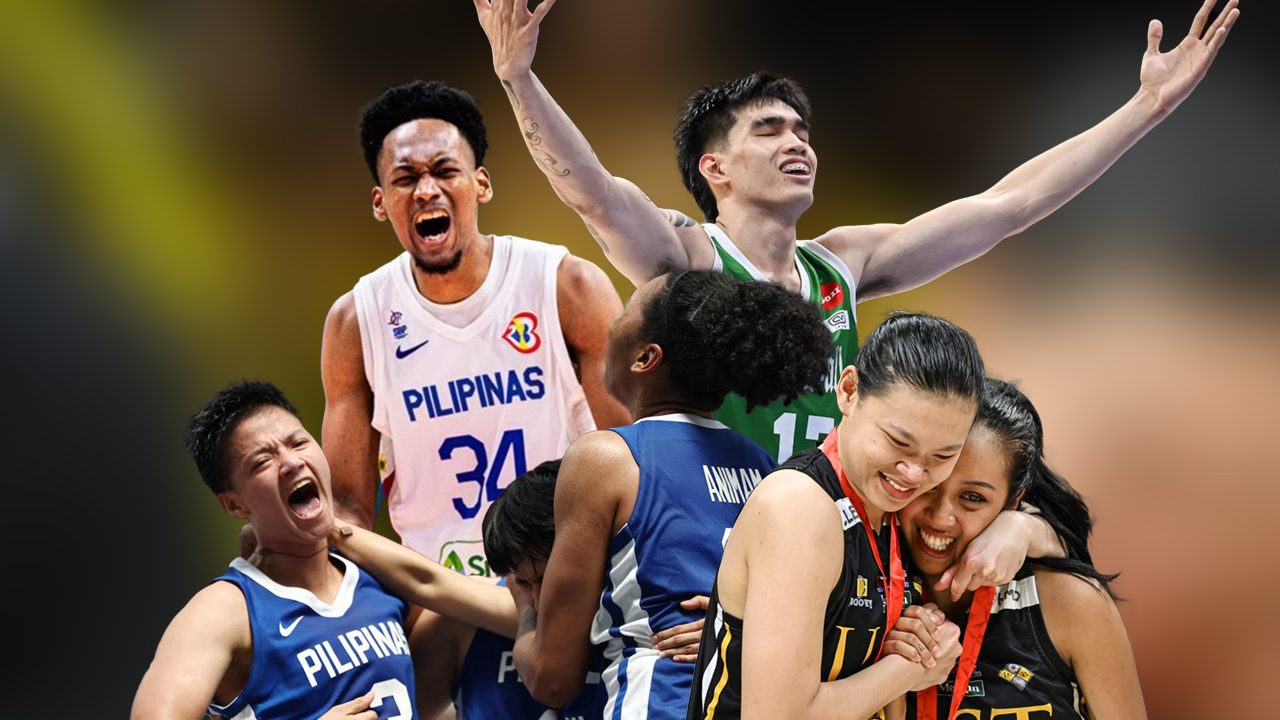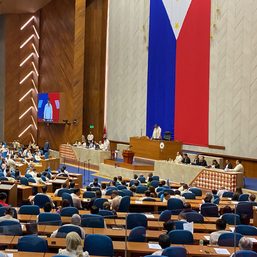SUMMARY
This is AI generated summarization, which may have errors. For context, always refer to the full article.

MANILA, Philippines – 2023 has been an eventful year for Philippine sports. At its centerpiece, a constant amidst all the changes in the sporting landscape, remains the country’s most popular spectator event, basketball.
However, unlike in past decades when most significant stories about the game primarily revolved around the PBA and Gilas Pilipinas, 2023 showed that there were narratives that extended beyond those two entities. This year revealed that basketball in the Philippines was not just the PBA and Gilas, and that made for a richer tapestry in the game closest to the hearts of Filipinos. All it took was to hold good quality games played in credible basketball leagues.
Gilas Women emerge among Asia’s elite
The program that coach Pat Aquino painstakingly built the past couple of years finally resulted in the Gilas Women earning their spot among Asia’s elite in 2023, something which just a few years back seemed an improbable proposition.
Of course, there were some minor hiccups along the way, such as the team’s inability to win a third straight Southeast Asian Games gold.
But Gilas Women still advanced further to become a significant force even outside Southeast Asia.
In the FIBA Women’s Asia Cup held from June 26 to July 2 in Australia, the Philippines placed a historic sixth, ahead of higher-ranked Chinese Taipei and Lebanon.
Gilas Women could have placed higher had they beaten New Zealand in the quarterfinals in a game where the Philippines led by a point at the end of the third quarter. The Filipinas lost to the Tall Ferns by just 5 points, 83-78. In the battle for fifth, Gilas Women dropped another close game to world No. 13 South Korea, 80-71.
To further cement its status among the continent’s elite, Gilas Women saw action in the Asian Games for the first time in Hangzhou, China, in September. The team did not disappoint, compiling a 2-1 in the group stage to reach the quarterfinals. The team fell short of a podium finish at fifth.
The success of the national program extended to the youth squad, which went undefeated in Division 2 of the FIBA Under-16 Women’s Asian Championship to earn a spot in Division 1. The Gilas Girls won all their five games by an average of 53 points in the competition held last July in Amman, Jordan.
Gilas Women will end 2023 secure in the thought that they could have another banner year in 2024.
The pipeline of youthful talent coming up the ranks is deep. Old reliables Afril Bernardino, Janine Pontejos, Camille Clarin, Khate Castillo, Ella Fajardo, and Angel Surada are always ready for a call-up. Jack Animam is slowly regaining her old form as evidenced by her stats in the Women’s Chinese Basketball Association, where she averages a double-double.
New faces Jhazmin Jocson and Louna Ozar have been a big boost to the program. Animam joining forces with UAAP MVP Kacey Dela Rosa of the Ateneo is a tantalizing prospect which will give the team something it has never had the luxury of having before in a major FIBA competition – a twin tower combination that is potent on both ends of the floor.
Asian Games gold, finally
The gold-medal finish in the Hangzhou Asian Games was but a fitting reward for Gilas’ program which had been defined by more controversies than victories ever since Tab Baldwin stepped down from his coaching post in early 2022.
Not even the controversy surrounding Justin Brownlee’s positive drug test result could take away the luster of the Asiad gold, which a hastily-formed Gilas team copped against seemingly insurmountable odds.
Tim Cone, when asked prior to the team flying to Hangzhou what the goal of the team was, replied matter-of-factly to win the gold. This was a straightforward reply by a head coach who knew what he wanted and possessed the tactical maturity to put into action the game plan needed to produce the result.
It was a refreshing approach compared to how former Gilas coach Chot Reyes constantly reminded people that the bigger goal of the program is to prepare the team for the 2023 FIBA World Cup – the convenient, default excuse each time the squad suffered the ignominy of defeat in the SEA Games or a blowout loss to teams they should have been competitive with.
And so when Cone and his Gilas crew struck gold in the Asian Games, it somewhat helped erase the bitter taste that lingered in the mouths of fans who got caught up in the whole would-Chot-resign/would-Chot-remain debate.
The gold was for the 1990 RP team coached by Robert Jaworski that made the finals but fell short of the crown. It was for the Cone-mentored Centennial Team which settled for the bronze in 1998. It was for Olsen Racela and the 2002 squad, who were two free throws away from a spot in the championship.
The gold was for Scottie Thompson, who rushed his return to Gilas’ lineup for the World Cup despite not being fully recovered, all because he wanted to fight for flag and country. It was for Kevin Alas, who has had to overcome career-threatening injuries but remained always ready for a Gilas call-up. It was for Calvin Oftana, Chris Newsome, and Angelo Kouame, who proved they deserve their Gilas spots. It was for Junemar Fajardo and Japeth Aguilar, who have been mainstays of the national squad for over a decade.
By dethroning China in the semifinals and outgunning Jordan in the finals, the Philippines bagged its first crown in Asian Games men’s basketball since 1962 and its first major international basketball title since the 1985 Asian Basketball Confederation Championship (now known as the FIBA Asia Cup). Ultimately, the gold is for Gilas fans who still stood by the team despite enduring years of frustration.
The women’s game is vibrant and alive
The National University Lady Bulldogs’ dynasty in the UAAP was a marvel to witness.
The end of the Lady Bulldogs’ run may have brought tears to the NU campus, but the bigger picture unveiled a women’s basketball environment that is slowly raising its caliber as it continues to grow and become more mainstream.
Coach Haydee Ong has long been the standard by which women coaches in the country are measured, and she once again displayed her astute understanding of the game by leading the UST Growling Tigresses to the UAAP Season 86 title, their first since 2006. Not only did UST snap a 20-game skid against NU, the Tigresses also brought an end to the Lady Bulldogs’ seven-season reign by coming from behind to snatch a 71-69 victory in Game 3 of the UAAP finals. The likes of Kent Pastrana, Tantoy Ferrer, and Nikki Villasin have certainly earned second looks from Gilas Women’s coaching staff.
The Lady Bulldogs still managed to impose their will in the elimination round after finishing with a 13-1 record, but other teams such as the UP Fighting Maroons, which posted a 10-4 record and dragged the Tigresses to a do-or-die match in the semifinals, and the Ateneo Blue Eagles, who earned an 8-6 slate, inched closer to the traditional powers. The La Salle Lady Archers were not far behind, registering an even 7-7 card.
Admittedly, women’s basketball is still rather far from achieving the interest that women’s volleyball and women’s football through the Filipinas have generated. But the quality of play, the passion of the players and coaches, and the competitiveness of games in women’s basketball are all ingredients that could spark newfound attention from fans that Filipina women ballers so richly deserve.
Basketball comes home to the Philippines
The game of basketball finally came back home to the country where fans’ love for the game is unparalleled when the Philippines served as the main host of the FIBA World Cup from August 25 to September 10. It marked the second time the World Cup was held on local shores since the country hosted the 1978 edition.
The opening day of the world’s most prestigious FIBA event gave everyone a glimpse of what eventually would become the biggest World Cup staging. A total of 38,115 were present to witness Gilas Pilipinas duke it out against NBA star Karl Anthony Towns and the Dominican Republic at the Philippines Arena. The crowd easily trumped the previous FIBA record of 32,616 fans who watched the USA-Russia finals during the 1994 World Cup held in Toronto, Canada.
This year’s edition of the FIBA’s centerpiece event was broadcast in 190 territories. The highest broadcast rating in Japan for 2023 was the FIBA World Cup match between Japan and Cape Verde, while the encounter between Gilas and Angola became the second-highest sports audience of 2023 in the Philippines. A new crowd record of 700,665 watched the games live during the course of the competition in jointly-hosted by Manila, Jakarta, and Okinawa.
Fans came out to support not only live but also virtually across the entire spectrum of broadcast, social media, and digital platforms, resulting in triple the impressions and engagement compared to the 2019 World Cup in China.
The PBA remains the sick league in Asia
Everyone knows it. Everyone says so. Everyone, except the PBA, which in 2023 continued to live off its past glory even as it could not even muster the crowd attendance that other local and even regional leagues are able to attract on a regular basis.
The PBA draws a sizable crowd during Manila Clasico games, but how much can the league really milk a Barangay Ginebra-Magnolia matchup? The only other times the PBA experienced sell-out crowds was when Ginebra played the Bay Area Dragons in the Commissioner’s Cup finals earlier this year.
That the PBA needs a guest team to gain fan interest already is telling.
The league has long been left behind by more progressive professional leagues in Asia like the Japan B. League and the Korean Basketball League. The list of Filipinos who have decided to take their talents to Japan and Korea reads like a veritable who’s who. The quality of players who have joined the exodus to these foreign leagues is enough to form a really strong Gilas Pilipinas national team. Not only do they get paid more, but they also get to play in higher level leagues whose integrity has not yet been tarnished.
Still, the PBA refuses to admit there is something wrong and holds on to the illusion that it is still the gold standard of professional basketball. Not even Gilas’ gold-medal title conquest in the Asian Games can negate the fact that the PBA has fallen behind primarily due to its lack of imagination and stubborn refusal to mend its old ways.
And so the league continues to be ruled by teams belonging to major blocs, while the rest of the field make do with the few marquee players who have not yet been snagged by richer teams. The PBA still turns a blind eye on lopsided trades and deals between sister teams which involve conduits, something an ordinary fan could see right through yet somehow miraculously are undetected by league officials. And the PBA remains the only league which imposes a height limit on imports. All laughable, yet the PBA still does not want to acknowledge how its actions, and inaction, have turned the league into one big fat joke.
New collegiate kings
New champions emerged from the UAAP and the NCAA. Not totally new, as both schools have rich championship traditions and have won consecutive titles in the past.
La Salle broke the stranglehold of Ateneo and UP by crashing the finals and winning the last two games of the Season 86 finals against the Maroons to capture its first title in seven years.
San Beda also followed the same script, dropping Game 1 to Mapua before bagging Games 2 and 3 of the Season 99 title series.
The results from both the UAAP and the NCAA again are indicative of the level playing field that has come to mark both premier collegiate leagues.
The UAAP crowned its third different champion in three years, with La Salle following Season 85 titlist Blue Eagles and Season 84 champion Maroons.
In the NCAA, Mapua made the finals after missing out on the Final Four the previous year, while defending champion Letran did not even reach the semifinals this year.
When you have good quality games from credible leagues, fans will come out in droves to support.
In Game 3 of the UAAP finals, 25,192 fans filled up the Araneta Coliseum to witness La Salle’s ascension as the new kings of UAAP basketball. In the penultimate playdate of the NCAA, 23,077 fans were on hand when San Beda reclaimed the title. – Rappler.com
Add a comment
How does this make you feel?





There are no comments yet. Add your comment to start the conversation.